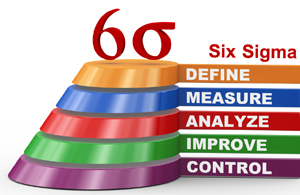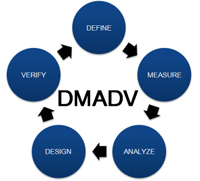The Six Sigma initiative is used by organizations to employ a structured, systematic approach to achieve operational excellence across all areas of the organization. The Six Sigma initiative utilizes specific tools, which include templates, process analysis techniques, statistical tests and deployment aids. These Six Sigma tools are used to implement DMAIC and DMADV projects that lead to organizational performance-improvement initiatives.
Fundamentals of DMAIC
 The Six Sigma DMAIC methodology is used when an organization is improving its existing processes during a process improvement project. The acronym DMAIC represents five project phases: Define, Measure, Analyze, Improve, and Control.
The Six Sigma DMAIC methodology is used when an organization is improving its existing processes during a process improvement project. The acronym DMAIC represents five project phases: Define, Measure, Analyze, Improve, and Control.
During the define phase, the Six Sigma team will define the project’s problem in an outline for themselves and the organization’s leaders. During the measure phase, the project team maps the current process, gathers data, and identifies and understands the root cause of the process. Working in conjunction with the measure phase is the analyze phase, which is when the project team analyzes the data and the process to reduce while validating the wastes and defects of the existing process. The improve phase is initiated when the team has completed analyzing the process and is ready to move forward with working on the defects by implementing their improvement ideas. The final phase of DMAIC is the control phase. In this phase, the team will document how the process improvements will be passed to the organization’s employees who work within the process.
Fundamentals of DMADV
 The Six Sigma DMADV methodology is used when an organization is creating new processes in order to achieve their customers’ needs. The acronym DMADV represents five project phases: Define, Measure, Analyze, Design, and Verify.
The Six Sigma DMADV methodology is used when an organization is creating new processes in order to achieve their customers’ needs. The acronym DMADV represents five project phases: Define, Measure, Analyze, Design, and Verify.
During the define phase, the Six Sigma team will define the project’s goals and deliverables. In the measure phase, the team measures the project’s factors that are critical to its deliverables. Working in conjunction with the measure phase is the analyze phase, when the team analyzes the process options that will best meet the customer’s required deliverables. The design phase is the phase in which the team will document the detailed process that meets the customer’s deliverables. The final phase of DMADV is the verify phase, in which the team will verify that the customer’s needs are met through the use of the newly designed process.
DMAIC vs. DMADV
DMAIC and DMADV are two Six Sigma methodologies that share a few common traits, but cannot be used simultaneously on the same project or interchanged because they are designed for use in different facets of organizational processes.
DMAIC and DMADV are similar in that they are both used to:
- reduce the number of defects to less than 3.4 per million opportunities
- find quality related solutions to problems using data and statistical tools
- help achieve an organization’s financial and business objectives
DMAIC and DMADV are also similar in the fact that they both require the use of certified Green, Black, and Master Black Belts, and require the support from a Project Champion and Process Owner.
DMAIC and DMADV are different in that DMAIC is used to improve existing processes while DMADV is used when creating new processes.
DMAIC focuses on:
- defining business processes
- measuring the current performance of a business process
- finding the root cause of a problem
- making improvements to the business process to reduce defects
- implementing controls to alert leadership when the process is no longer in control.
DMADV focuses on:
- defining the customer’s needs
- measuring the customer’s needs
- finding process options that will meet the customer’s needs
- designing a business model that helps meet the customer’s needs
- verifying that the new model meets the customer’s needs
For more information on the fundamentals of these processes, please visit our detailed informational pages on DMAIC and DMADV.
- DMAIC (Define, Measure, Analyze, Improve, and Control)
- What is DMAIC?
- What is DMADV?



